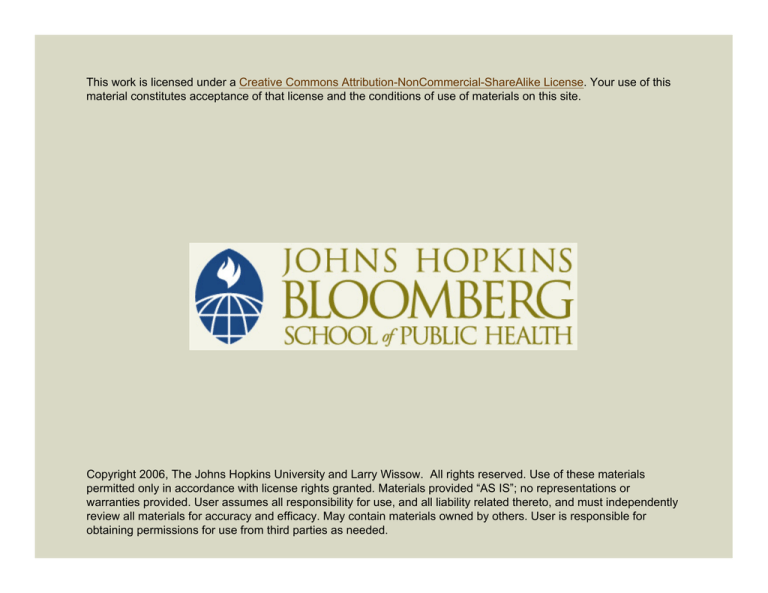
This work is licensed under a Creative Commons Attribution-NonCommercial-ShareAlike License. Your use of this
material constitutes acceptance of that license and the conditions of use of materials on this site.
Copyright 2006, The Johns Hopkins University and Larry Wissow. All rights reserved. Use of these materials
permitted only in accordance with license rights granted. Materials provided “AS IS”; no representations or
warranties provided. User assumes all responsibility for use, and all liability related thereto, and must independently
review all materials for accuracy and efficacy. May contain materials owned by others. User is responsible for
obtaining permissions for use from third parties as needed.
Workplace environments
and making change in
medical systems
Larry Wissow
Professor
Health, Behavior and Society
Johns Hopkins School of Public Health
The Problem
Big movement for guideline-based and
evidence-based care
Motivation goes way back to “small area
variation” studies
7-fold differences in tonsillectomy rates among
New England states
In Maryland around 1980: more likely to have
head CT if lived near Cumberland, more likely to
have hysterectomy if lived on the Eastern Shore,
more likely to have urethral dilatation if live near
Frederick
The Problem
Clinicians know what is “right” but find many
reasons not to do it
Simply disseminating guidelines does not
work
Many reasons behind failure
Need to draw on many fields to find solutions
Preparing Materials
Need to be visually appealing
Need to be simple to use
Requires participation of target audience in
drawing them up
Interactive process of “storyboarding”
Different Modes of Clinician
Thinking
Guidelines are “logic models,” decision-trees,
hypothetico-deductive
Clinicians generally don’t think that way
Work by pattern recognition
Pursue things considered most likely until get
feedback that formulation is incorrect
Conception of what is correct can lead to failure to
see evidence of failure!
Example of Thinking Patterns
Deductive approach to ADHD
Assess symptoms, consider fit with various
diagnostic possibilities, sequentially “rule in” or
“rule out” various options
Pattern recognition
“Hyperactive” child “looks like” ADHD – treat with
medication and see what happens
Other Problems with Thinking
Patterns
Clinicians like to think scientifically but distrust
scientists
Question motivation
Feel researchers are out of touch with need to
function in environment marked by uncertainty
Greer: Science is abstract and open-ended;
practice is concrete and forces closure.
Problems with Guideline
Content (Cabana)
Current wisdom at odds with guidelines
Lack of outcome expectancy
Not convinced it will work
Not convinced it is any better
Doesn’t meet needs
Lack of self-efficacy
Don’t have skills or materials needed
Problems with Guideline
Content (Crabtree)
Problem not patient oriented
Resist guidelines with more holistic approach
Don’t see scope of information as what would
normally be collected in standard encounter
May have “disease” versus prevention
orientation
Problems with Change in
General
“Competing demands”
That’s nice, but other changes have higher priority
Demand-control (Karasek)
Workers “strained” when have many demands but
perceive little freedom
Doctors’ biggest complaint is loss of autonomy
Low-autonomy reduces openness to change
Difficulty Teaching People
New Skills
Learners’ choices of education topics
What they like, not what they need to know
Attend for reasons beyond educational
Respite
Social
Learner satisfaction a poor judge of
information transfer
“Dr. Fox” lecture
What Does Seem to Work?
Emphasize research/science base
Participatory (but low risk) learning activities
This is a major “bind” in teaching designs
Recognize different learning styles
Have a variety available
Peer to peer teaching
“ratifies” what authorities say
Peer-to-Peer Processes
Multi-step process
Hear something interesting
Wait to see if peers approve, are using
Want to be part of consensus
So clinical innovation often requires someone
who will “break ground”
Need to recruit opinion leader
But one who acts, not just person in authority
Giving Feedback
Feedback is a critical step in most “quality
assurance” programs
“Closing the loop” -- what are the results of
what you have done
Doesn't always work
Ignored
Resisted
Heard but makes things worse
Who Gives Feedback
Self-generated from reflection
Individuals in authority
“360-degree”
Unrelated others
Clients
Influences on Attention to
Feedback
Credibility of source
Objectivity, expertise
Accountability to do something with info
Feel responsibility for outcome
Novelty and utility of information
New information
Simple enough to act on
Influences on Attention to
Feedback
Variation from expectation
Small differences from expectation ignored
Large deviations tend to be dismissed as inaccurate
“Source” of problem
Like good news related to inherent traits
Avoid bad news about inherent traits
Attend to bad news about modifiable traits
Feedback and Goals
Pay attention to feedback when buy into the
goal of getting it
Characteristics of useful goals
Non-trivial (more difficult evokes better
performance, but attainable)
Specific – give me a precise target
Attractive – buy into desired outcome
Withstands challenge of competing goals
Characteristics of Successful
Feedback Programs
Involve staff in planning!
Prior agreement on goals and responsibility for
outcomes
Accepted measurement tool
Credible information sources
Provides new and useful information
Focuses on modifiable factors
But Need to Think bigger
What is a medical practice? (Crabtree)
“An adaptive system” with specific strengths and
weaknesses
Composed of people who communicate with each
other, have various skills
Change in one part impacts others
Has a values and expertise that influence approach
to change
What Is a Practice
Multiple goals
Care for patients
Provide for livelihood and careers of each staff
member
Provide social environment for staff
Provide intellectual environment for staff
May include larger societal goals
Readiness for Change
Staff role expectations
Clear? Flexible?
Quality of intra-staff communication
Sense of common goals
Efficiency
Perception of work burden
Catalysts for Change
“Bee in the bonnet” person
Major change in environment
Different patient population
Change in economic environment
Role models/outside innovators
Summary for Implementing
Change
One size does not fit all
Need to address organization's specific
characteristics
Simultaneous focus on individuals and
systems
Goals are key
What are they now?
What new ones might be endorsed?


